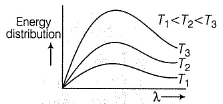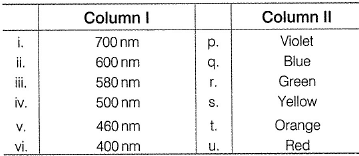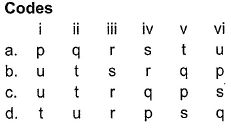All Exams >
EmSAT Achieve >
Chemistry for EmSAT Achieve >
All Questions
All questions of Electromagnetic Radiation for EmSAT Achieve Exam
Direction (Q. Nos. 12 and 13) This section contains a paragraph, wach describing theory, experiments, data etc. three Questions related to paragraph have been given.Each question have only one correct answer among the four given ptions (a),(b),(c),(d)A hypothetical electromagnetic wave is pictured here. Q. Energy associated with this wave is
Q. Energy associated with this wave is- a)4.24 x 10-19J
- b)2.12 x 10-19J
- c)1.06 x 10-19J
- d)8.49 x 10-19J
Correct answer is option 'A'. Can you explain this answer?
Direction (Q. Nos. 12 and 13) This section contains a paragraph, wach describing theory, experiments, data etc. three Questions related to paragraph have been given.Each question have only one correct answer among the four given ptions (a),(b),(c),(d)
A hypothetical electromagnetic wave is pictured here.
Q. Energy associated with this wave is
a)
4.24 x 10-19J
b)
2.12 x 10-19J
c)
1.06 x 10-19J
d)
8.49 x 10-19J
|
|
Hansa Sharma answered |
A to E makes one complete wave.
Energy of a mole of radio wave photons with a frequency of 909 kHz is- a)6.02 x 10-28 J
- b)3.62 x 10-4 J
- c)1.00 x 10-4 J
- d)6.02 x 10-31 J
Correct answer is option 'B'. Can you explain this answer?
Energy of a mole of radio wave photons with a frequency of 909 kHz is
a)
6.02 x 10-28 J
b)
3.62 x 10-4 J
c)
1.00 x 10-4 J
d)
6.02 x 10-31 J
|
|
Rajeev Nair answered |
E = N0hv
= 6.02 x 1023 x 6.62 x 10-34 Js x 909 x103 s-1
= 3.62 x 10-4 J
= 3.62 x 10-4 J
Direction (Q. Nos. 1-8) This section contains 8 multiple choice questions. Each question has four choices (a), (b), (c) and (d), out of which ONLY ONE option is correct.
Q. FM radio broadcasts at 900 kHz. What wavelength does this corresponds to?- a)333 m
- b)3.03 x 10-3m
- c)330 m
- d)3300 m
Correct answer is 'A'. Can you explain this answer?
Direction (Q. Nos. 1-8) This section contains 8 multiple choice questions. Each question has four choices (a), (b), (c) and (d), out of which ONLY ONE option is correct.
Q. FM radio broadcasts at 900 kHz. What wavelength does this corresponds to?
a)
333 m
b)
3.03 x 10-3m
c)
330 m
d)
3300 m
|
|
Soumya Mukherjee answered |
Understanding FM Radio Frequency and Wavelength
FM radio broadcasts at a frequency of 900 kHz. To find the corresponding wavelength, we can use the formula that relates frequency and wavelength in a vacuum:
Formula for Wavelength
Wavelength (λ) = Speed of Light (c) / Frequency (f)
Where:
- Speed of Light (c) ≈ 3 x 10^8 meters per second
- Frequency (f) = 900 kHz = 900,000 Hz (since 1 kHz = 1,000 Hz)
Calculating the Wavelength
Using the values:
- λ = (3 x 10^8 m/s) / (900,000 Hz)
- λ = (3 x 10^8) / (9 x 10^5)
- λ = 333.33 meters
Thus, the wavelength that corresponds to a frequency of 900 kHz is approximately 333 meters.
Conclusion
So, the correct answer to the question is:
- Option (a): 333 m
This calculation illustrates how the frequency of radio waves is inversely related to their wavelength; as frequency increases, wavelength decreases.
FM radio broadcasts at a frequency of 900 kHz. To find the corresponding wavelength, we can use the formula that relates frequency and wavelength in a vacuum:
Formula for Wavelength
Wavelength (λ) = Speed of Light (c) / Frequency (f)
Where:
- Speed of Light (c) ≈ 3 x 10^8 meters per second
- Frequency (f) = 900 kHz = 900,000 Hz (since 1 kHz = 1,000 Hz)
Calculating the Wavelength
Using the values:
- λ = (3 x 10^8 m/s) / (900,000 Hz)
- λ = (3 x 10^8) / (9 x 10^5)
- λ = 333.33 meters
Thus, the wavelength that corresponds to a frequency of 900 kHz is approximately 333 meters.
Conclusion
So, the correct answer to the question is:
- Option (a): 333 m
This calculation illustrates how the frequency of radio waves is inversely related to their wavelength; as frequency increases, wavelength decreases.
A gas absorbs photon of wavelength 355 nm and emits at two wavelengths. If one of the emissions is at 680 nm, the other is at[AlEEE 2011]- a)1035nm
- b)325 nm
- c)743 nm
- d)518 nm
Correct answer is option 'C'. Can you explain this answer?
A gas absorbs photon of wavelength 355 nm and emits at two wavelengths. If one of the emissions is at 680 nm, the other is at
[AlEEE 2011]
a)
1035nm
b)
325 nm
c)
743 nm
d)
518 nm
|
|
Nandini Patel answered |
1/λ = 1/λ1 + 1/λ2
1355 = 1680 + 1λ2
1/λ2 = (680 − 355/680 x 355)
⇒ λ2 = 743nm.
Select the incorrect statement about cathode rays.- a)They travel from cathode to anode
- b)They travel in a straight line in the absence of an external electrical or magnetic field
- c)Their nature is independent of the materials of cathode
- d)Their nature is dependent on the nature of the gas present
Correct answer is option 'D'. Can you explain this answer?
Select the incorrect statement about cathode rays.
a)
They travel from cathode to anode
b)
They travel in a straight line in the absence of an external electrical or magnetic field
c)
Their nature is independent of the materials of cathode
d)
Their nature is dependent on the nature of the gas present

|
Amrita Sarkar answered |
(a) Cathode rays travel from cathode (source) to anode. True
(b) In the absence of these fields, they are not deflected but in the presence of electrical field, they are deflected indicating that they are charged. Thus, True
(c) Their nature is independent of the material of cathode. True
(d) Their nature is independent of the nature of the gas.
Thus, given statement is false.
(b) In the absence of these fields, they are not deflected but in the presence of electrical field, they are deflected indicating that they are charged. Thus, True
(c) Their nature is independent of the material of cathode. True
(d) Their nature is independent of the nature of the gas.
Thus, given statement is false.
Select the correct statement(s).
- a)The ideal body, which emits and absorbs all frequencies is called a black body
- b)The exact frequency distribution of the emitted radiation from a black body depends upon its temperature
- c)The radiation emitted goes from a lower frequency to higher frequency as the temperature increases
- d)In vacuum, all types of electromagnetic radiation travel at the same speed
Correct answer is option 'A,B,C,D'. Can you explain this answer?
Select the correct statement(s).
a)
The ideal body, which emits and absorbs all frequencies is called a black body
b)
The exact frequency distribution of the emitted radiation from a black body depends upon its temperature
c)
The radiation emitted goes from a lower frequency to higher frequency as the temperature increases
d)
In vacuum, all types of electromagnetic radiation travel at the same speed

|
Sushant Khanna answered |
(a) Correct
(b) As temperature increases, distribution of frequency (and energy) increases. Thus, correct.

(c) As temperature increases, radiation emitted is shifted to lower wavelength, i.e. higher frequency. Correct
(d) All types of radiations have same speed 3 x 108 ms-1. Correct
(b) As temperature increases, distribution of frequency (and energy) increases. Thus, correct.
(c) As temperature increases, radiation emitted is shifted to lower wavelength, i.e. higher frequency. Correct
(d) All types of radiations have same speed 3 x 108 ms-1. Correct
Direction (Q. Nos. 15 and 16) This section contains 2 questions. when worked out will result in an integer from 0 to 9 (both inclusive)Q. In Millikan’s experiment, static electric charge on the oil drops has been obtained by shining X-rays. If the static electric charge on the oil drop is -1.282x 10-18 C, calculate the number of electrons present on it.
Correct answer is '8'. Can you explain this answer?
Direction (Q. Nos. 15 and 16) This section contains 2 questions. when worked out will result in an integer from 0 to 9 (both inclusive)
Q. In Millikan’s experiment, static electric charge on the oil drops has been obtained by shining X-rays. If the static electric charge on the oil drop is -1.282x 10-18 C, calculate the number of electrons present on it.

|
Manisha Mehta answered |
Charge on one electron = - 1.6022 x 10-19C
Let, number of electrons = N
Then total charge = - N x 1.6022 x 10-19C
Given, total charge = -1.282 x 10-18 C
Thus, - N x 1.6022 x 10-19 C = - 1. 282 x 10-18C
Let, number of electrons = N
Then total charge = - N x 1.6022 x 10-19C
Given, total charge = -1.282 x 10-18 C
Thus, - N x 1.6022 x 10-19 C = - 1. 282 x 10-18C
∴ N = 8
Which of the following conclusions could not be derived from Rutherford’s α-particle scattering experiment?- a)Electrons and nucleus are held together by electrostatic forces of attraction
- b)The radius of the atom is larger than that of the nucleus
- c)Most of the space in the atom is empty
- d)Electrons move in a circular path of fixed energy. Circular paths are called orbits
Correct answer is option 'D'. Can you explain this answer?
Which of the following conclusions could not be derived from Rutherford’s α-particle scattering experiment?
a)
Electrons and nucleus are held together by electrostatic forces of attraction
b)
The radius of the atom is larger than that of the nucleus
c)
Most of the space in the atom is empty
d)
Electrons move in a circular path of fixed energy. Circular paths are called orbits

|
Dipika Choudhury answered |
(a) Electrons (-) and nucleus (+) are held togeather by electrostatic forces of attractions. Thus. true.
(b) Radius of the atom (= 10-10m) > radiue of the nucleus (10-15m). Thus true
(c) Most of the space is empty as given by radius of the nucleus and atom. Thus, true.
(d) As electron moves in a circular paith, it emits energy and ultimately false into nucleus. Thus, false.
(b) Radius of the atom (= 10-10m) > radiue of the nucleus (10-15m). Thus true
(c) Most of the space is empty as given by radius of the nucleus and atom. Thus, true.
(d) As electron moves in a circular paith, it emits energy and ultimately false into nucleus. Thus, false.
A hypothetical electromagnetic wave is pictured here. Q. A standing wave in a string 42 cm long has a total of six nodes (including those at the ends). Wavelength of the standing wave is
Q. A standing wave in a string 42 cm long has a total of six nodes (including those at the ends). Wavelength of the standing wave is- a)7.0 cm
- b)16.8 cm
- c)10.5 cm
- d)5.25 cm
Correct answer is option 'B'. Can you explain this answer?
A hypothetical electromagnetic wave is pictured here.
Q. A standing wave in a string 42 cm long has a total of six nodes (including those at the ends). Wavelength of the standing wave is
a)
7.0 cm
b)
16.8 cm
c)
10.5 cm
d)
5.25 cm

|
Ayush Joshi answered |
If there are 6 nodes, then there are 5 segments between nodes, and the wavelength of the underlying wave is 2 of those (because they look similar when they’re moving but if you freeze-frame, every second one is the opposite direction), so I make it 2*42/5 = 16.8 cm.
Direction (Q. Nos. 14) Choice the correct combination of elements and column I and coloumn II are given as option (a), (b), (c) and (d), out of which ONE option is correct. Q. The colours of visible light are at different wavelength. Match the wavelengths in Column I with their colours in Column II.

- a)a
- b)b
- c)c
- d)d
Correct answer is option 'B'. Can you explain this answer?
Direction (Q. Nos. 14) Choice the correct combination of elements and column I and coloumn II are given as option (a), (b), (c) and (d), out of which ONE option is correct.
Q. The colours of visible light are at different wavelength. Match the wavelengths in Column I with their colours in Column II.
a)
a
b)
b
c)
c
d)
d

|
Ishita Reddy answered |
Thus, (i)(700nm) Red (u)
(ii) (600 nm) - Orange (t)
(iii) (580 nm) - Yellow (s)
(iv) (500nm) - Green (r)
(v) (460 nm) - Blue (q)
(vi) (400 nm) - Violet (p)
(ii) (600 nm) - Orange (t)
(iii) (580 nm) - Yellow (s)
(iv) (500nm) - Green (r)
(v) (460 nm) - Blue (q)
(vi) (400 nm) - Violet (p)
Chapter doubts & questions for Electromagnetic Radiation - Chemistry for EmSAT Achieve 2025 is part of EmSAT Achieve exam preparation. The chapters have been prepared according to the EmSAT Achieve exam syllabus. The Chapter doubts & questions, notes, tests & MCQs are made for EmSAT Achieve 2025 Exam. Find important definitions, questions, notes, meanings, examples, exercises, MCQs and online tests here.
Chapter doubts & questions of Electromagnetic Radiation - Chemistry for EmSAT Achieve in English & Hindi are available as part of EmSAT Achieve exam.
Download more important topics, notes, lectures and mock test series for EmSAT Achieve Exam by signing up for free.
Chemistry for EmSAT Achieve
191 videos|265 docs|160 tests
|


















